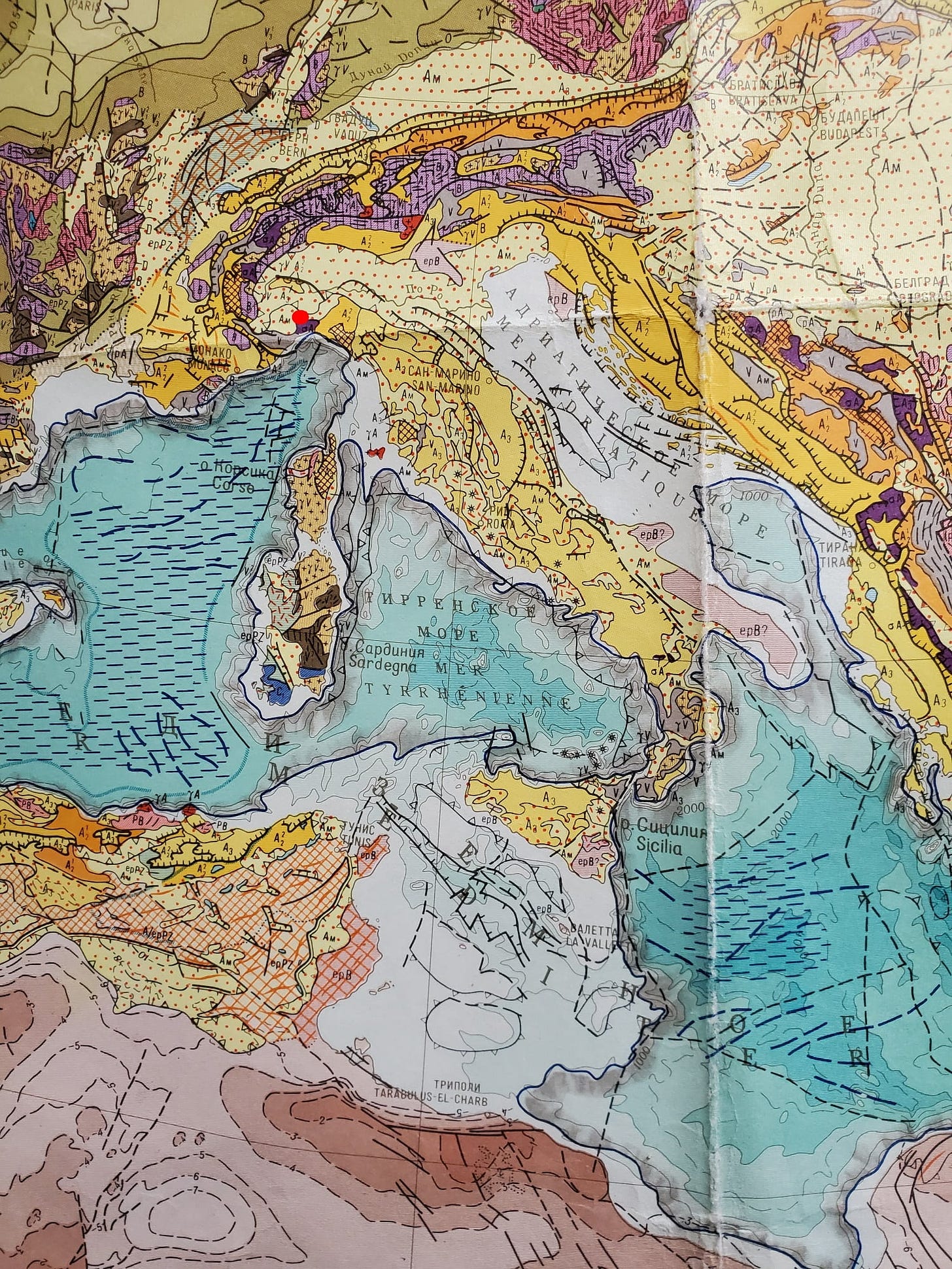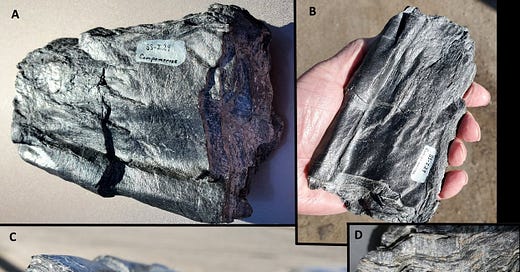Life in the USA is not normal. It feels pointless and trivial to be talking about small looks at the fascinating natural world when the country is being dismantled. But these posts will continue, as a statement of resistance. I hope you continue to enjoy and learn from them. Stand Up For Science!
I’ve been hauling this rock around a long time. I’m not certain where I got it – possibly a cast-off from the Flint Junior College geology department in the 1960s. It has an old label (white paint with India ink) that says “Campomorone.” The only location of that name I can find is northwest of Genoa, Italy, near the tectonic intersection of the Alps and the Apennines.
The best description for the rock type is phyllite, a low-grade metamorphic rock intermediate in grain size between slate and schist. It’s very fine grained, has a nice reflective sheen, and contains the little crinkles and crenulations (folds and/or kink bands) typical of phyllites. Phyllite ranges from light tan to brown to black depending mostly on the nature of the fine mica grains that usually comprise such rocks.
But I don’t think there is mica in this rock.
It looks black at first glance, but under the microscope it has an almost metallic dark blue-black color, and despite the sheen it does not show the tiny flakes typical of a micaceous rock. That would be consistent with the blueschist facies rocks reported from the Campomorone area, and mineralogically the material would be mostly glaucophane, an amphibole (sodium-magnesium-iron silicate) typical of blueschist rocks. Glaucophane often has a fibrous habit that (when it is very fine grained as my specimen is) gives the rocks that contain it a sheen like phyllite. Blueschists typically indicate low temperatures but high pressures that often occur in ferromagnesian rocks involved in subduction and more so in obduction, the pushing of oceanic crustal materials up and over continental rocks. This is unusual, in contrast to the typical descent of denser oceanic crust beneath continental rocks, but it does happen.
The protolith, the original rock, for blueschists is often the basaltic oceanic crust itself, but the thin layering in my rock does not seem reasonable even for metamorphosed basalt. I think this came from closely associated mud rocks, either derived directly from the basalt, or altered chemically during metamorphism. I won’t insist that the mineralogy is dominantly glaucophane, but I’m fairly sure.
The rocks at Campomorone were visited by the polymath and explorer Alexander von Humboldt in 1795 and 1805, when the science of geology was in its infancy. Federico (2020, In the footsteps of von Humboldt discovering central Liguria geology: Bull. Env. and Life Sciences, 2:91-95) retraced Humboldt’s travels and updated his interpretations.
According to Federico, Campomorone sits within the Figogna Unit of the Sestri-Voltaggio Zone, a unit that represents oceanic crust and associated rocks, including blueschist, phyllitic schist, and interbedded limestones. I don’t quite know what “phyllitic schist” means, but it is probably something someone construed as coarse phyllite or fine-grained schist, or some close combination of both. My rock seems to be pretty standard phyllite.
Campomorone is famous for ophicalcite, a rock made of serpentine (typical of metamorphosed oceanic crustal rocks) and calcite. Ophicalcite is really a breccia (broken rock, reconsolidated) of calcite, serpentine, and talc that has been used as a decorative building stone for centuries, sometimes under the name “green marble of Polcevera.” My rock is not from that material.
My specimen does contain very thin layers of fibrous calcite in the dominant dark steely blue material that I think is glaucophane, so it fits expectations for rocks from this area of northwestern Italy.

Tectonically and very generally, the Alps represent a collision between Europe and the Apulian Plate, a complex, elongate shred of Africa that includes parts of eastern Italy and most of the Adriatic Sea. Apulia is pushing into the underbelly of Europe like a fat pencil, raising the Alps at its tip. Western and central Italy including the Apennines are deformed further by sea-floor spreading in the Tyrrhenian Sea west of Italy. In all this complexity, on the “corner” of the Apulian Plate around Campomorone it looks like slices of oceanic crust were emplaced upon the developing Alpine mountain belt.
The oceanic crust inferred to exist at Campomorone had sediments upon it as it was tectonically pushed upward, including limestones and probably fine-grained shale. Exactly what rock the glaucophane phyllite in my specimen derives from is unknown at least to me; it could represent sediments enriched in magnesium that was dissolved from the oceanic crustal rocks, or possibly it might be some metamorphic aspect of the oceanic rocks themselves. I think it is most likely that it was a mud rock (shale) deposited on oceanic crust. The shale was altered and enriched with iron and magnesium during the tectonic and metamorphic processes that formed this zone between the Apennines and the Alps.
In the photos, A and B show the sheen pretty well, together with the smooth curves that represent the axes of folds in the rocks. C and D show the ends of the specimen and cross-sections of the folds; in D, you can see a little fault in the limb of the fold there. It’s really a cool rock even if I don’t fully understand it.






Geologists love interesting rocks. Blueschists have always been one of my favorite rocks. Unique and odd mineralogy, interesting metamorphic history - evidence of low-temp and very high pressures. Such a unique environment, and from subduction zones, easily one of the most unique environments on the planet. Whats not to like?
Another rheology good story.